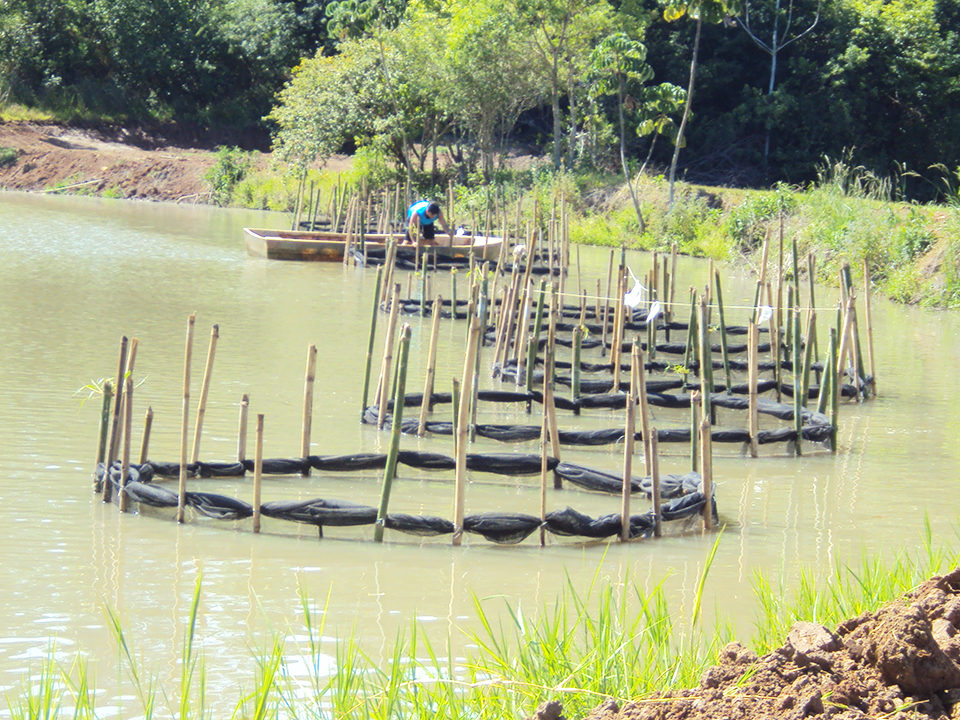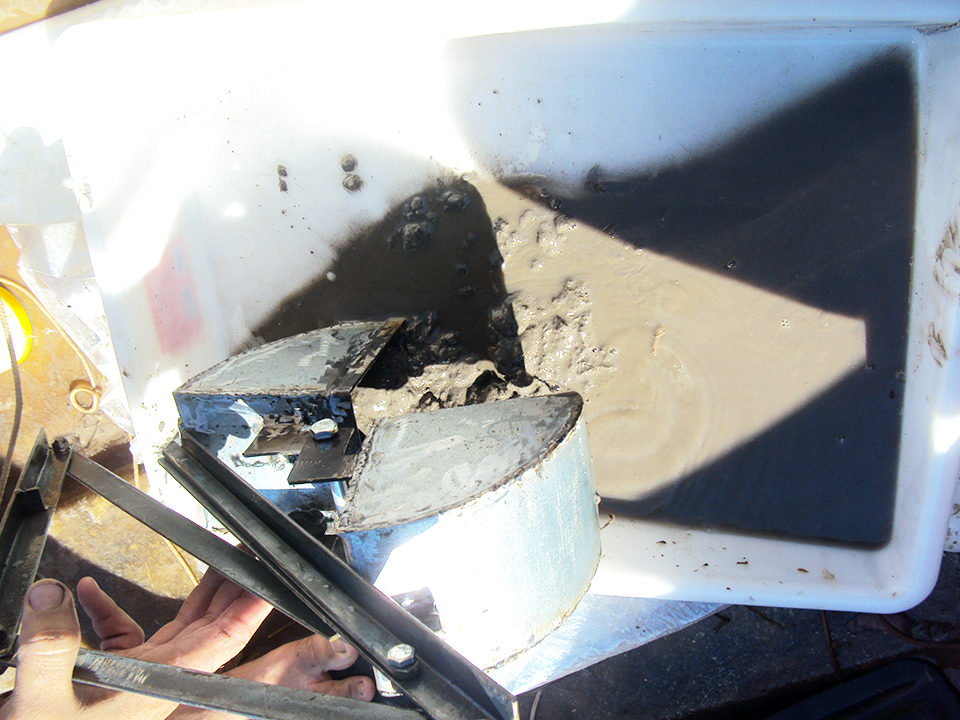Species has great socioeconomic and environmental importance in Brazil

The Amazon River prawn (Macrobrachium amazonicum) is a species with great production potential and important zootechnical characteristics such as quick growth and high tolerance to environmental conditions. Moreover, its high nutritional and gastronomic market values give it great socioeconomic and environmental importance in the northern and northeastern regions of Brazil. The M. amazonicum freshwater prawn is also widely sought in artisanal fishing. However, little is known about its nutritional requirements and feeding behavior under culture conditions.
Studies on the feeding behavior of prawns show that even in a production system with an artificial feed supply, natural feeding typically represents a significant part of these animals’ diets. Although most of the macronutrients needed for freshwater prawns are supplied by prepared feeds, the required micronutrient levels may derive from natural productivity. Previous studies showed that between 53 and 77 percent of the growth of Pacific white shrimp (Litopenaeus vannamei) was derived from grazing on natural food items present in ponds.
Several studies have shown that among the natural foods available, benthic fauna is an important food source in prawn farming. The benthic community is an important component in the sediment of rivers and lakes, and is crucial for the nutrient dynamics and transformation of matter into energy flow. It represents one of the main and essential food sources of the aquatic fauna, directly contributing to ecology dynamics.
The use of pens as experimental units in natural water bodies or ponds has allowed investigations of several aspects related to prawn feeding ecology and zootechnical performance.
Feeding study
A 60-day study was carried out by the authors in a commercial pond with M. amazonicum postlarvae weighing 0.63 ± 0.17 grams and measuring 4.28 ± 0.34 cm in length. The postlarvae were stocked at a density of 10 prawns per square meter in six pens with 10 m² of bottom area.
In Treatment P.F., prawns were fed a commercial diet with 35 percent crude protein at a rate equivalent to 10 percent of the total biomass. For treatment PNF, prawns in the remaining pens were not fed. In each pen, sediment samples were collected for analyses of the benthic community and sediment granulometry. The following water quality variables were monitored throughout the experiment: dissolved-oxygen concentration, temperature, pH, water transparency, nitrite and ammonia levels, alkalinity and hardness.
Results
Over the experimental period, temperatures ranged from 26.67 to 31.29 degrees-C. Dissolved oxygen had higher values in treatment P.F. (6.04 ± 1.80 mg/L) than in PNF (5.92 ± 1.80 mg/L). The pH values fluctuated slightly and remained close to neutral. The other variables had similar values between treatments (Table 1) and were within the suitable range for prawn culture. The granulometric fraction of the soil had a prevalence of sandy sediment.
Dutra, Mean and standard deviation values, Table 1
| Variables | Treatment PNF | Treatment P.F. |
|---|---|---|
| Water Temperature (° C) | 28.90 ± 2.23* | 29.00 ± 2.29 |
| Depth (cm) | 1.47 ± 0 | 1.47 ± 0.01 |
| Transparency (cm) | 28.95 ± 3.45 | 28.95 ± 3.46 |
| pH | 7.60 ± 0.75 | 7.60 ± 0.72 |
| Dissovled oxygen (mg/L) | 5.92 ± 1.80 | 6.04 ± 1.80 |
| Alkalinity (meq/L) | 25.31 ± 13.65 | 25.31 ± 13.65 |
| Hardness (mg/L) | 22.39 ± 9.51 | 22.39 ± 9.51 |
| Nitrite (mg/L) | 0.021 ± 0.016 | 0.021 ± 0.016 |
| Ammonia (mg/L) | 0.062 ± 0.103 | 0.062 ± 0.103 |
Table 1. Mean and standard deviation values for limnological variables in treatment prawns.
The final survival did not differ statically between treatments (Table 2). The average weights and total lengths also followed the same pattern at the end of the experiment, with individual weights of 4.43 ± 0.93 g for treatment PNF and 4.83 ± 1.03 grams for treatment P.F. The total average length was around 8.03 ± 0.43 cm in treatment PNF and 8.42 ± 0.51 cm in treatment P.F. Hence, it appeared the natural food was able to maintain prawn growth for several weeks with little or no input of supplementary feeding.
Dutra, Mean and standard deviation values, Table 2
| Treatments | Initial Body Weight (g) | Final Body Weight (g) | Initial Body Length (cm) | Final Body Length (cm) | Survival (%) | Feed-Conversion Ratio | Total Biomass (g) |
|---|---|---|---|---|---|---|---|
| PNF | 0.63 ± 0.05* | 4.43 ± 0.93 | 4.28 ± 0.14 | 8.03 ± 0.43 | 80.0 ± 9.6 | – | 352.97 ± 48.79 |
| P.F. | 0.63 ± 0.05 | 4.83 ± 1.03 | 4.28 ± 0.14 | 8.42 ± 0.51 | 73.0 ± 3.5 | 1.5:1 | 354.20 ± 16.96 |
Table 2. Mean and standard deviation values for the performance of tested prawns.
At the end of the experiment, ovigerous females were found in treatment P.F pens, but not in treatment PFN pens, which indicated that even though natural feeding supplied the basic needs of prawns over a certain period, artificial feeding still provided elements essential to prawn reproductive development.

Benthic macroinvertebrate community
During the experimental period, a total of 279,111 individuals were recorded for the benthic macrofauna studied (Table 3). The analysis revealed the presence of four main orders – Rhynchobdellida, Mesogastropoda, Ephemeroptera and Diptera – and one class, Oligochaeta. Within these orders, eight families were identified: Glossiphoniidae, Ceratopogonidae, Chaoboridae, Chironomidae, Polymitarcyidae and Ampullariidae.
Oligochaeta was the taxon occurring the most and with the greatest total abundance (91.28 percent) among the treatments. Total abundance was less notable for the other taxa: Chironomidae, 8.06 percent; Glossiphoniidae, 0.28 percent; Ceratopogonidae, 0.20 percent; Polymitarcyidae, 0.10 percent; and Chaoboridae, 0.06 percent. Ampullariidae was found only in the PNF treatment, at 0.02 percent of the total abundance (Table 3).
Dutra, Abundance of benthic macroinvetebrate communities, Table 3
| Taxa | Occurrence Of Benthic Community PNF Number | Occurrence Of Benthic Community PNF (%) | Occurrence Of Benthic Community P.F. Number | Occurrence Of Benthic Community P.F. (%) | Occurrence Of Benthic Community Total Number | Occurrence Of Benthic Community Total (%) |
|---|---|---|---|---|---|---|
| Annelida Rhynchobdellida Glossiphoniidae Oligochaeta* | 389 112,889 | 0.31 88.66 | 389 141,889 | 0.26 93.48 | 778 254,778 | 0.28 91.28 |
| Arthropoda Diptera Ceratopogonidae Chaoboridae Chironomidae | 333 111 13,389 | 0.26 0.09 10.51 | 222 56 9,111 | 0.15 0.04 6.00 | 556 167 22,500 | 0.20 0.06 8.06 |
| Ephemeroptera Polymitarcyidae | 167 | 0.13 | 111 | 0.07 | 278 | 0.10 |
| Mollusca Mesogastropoda Ampullariidae | 56 | 0.04 | – | – | 56 | 0.02 |
| Total | 127,333 | 100.00 | 151,778 | 100.00 | 279,111 | 100.00 |
No significant difference was determined between the treatments for the average total abundance of benthic macroinvertebrates over the experimental period, although reductions in some macroinvertebrate species were found. That indicated the prawns were able to adapt by increasing predation on the benthic community when there was no exogenous feeding.
(Editor’s Note: This article was originally published in the July/August 2014 print edition of the Global Aquaculture Advocate.)
Authors
-
Fabrício Martins Dutra, M.S.
Federal University of Paraná, Curitiba
Zoology Post-Graduation Program
Street Vinicius of Moraes, 661
Apartment 03, Dallas Garden
Palotina, Paraná, Brazil CEP 859500-000[114,98,46,114,112,102,117,64,100,109,111,105,99,105,114,98,97,102]
-
Dr. Yara Moretto
University of Paraná, Palotina
Aquaculture and Sustainable Development Post-Graduation Program
Palotina, Paraná, Brazil -
Dr. Leandro Portz
University of Paraná, Palotina
Aquaculture and Sustainable Development Post-Graduation Program
Palotina, Paraná, Brazil -
Dr. Eduardo Luis Cupertino Ballester
University of Paraná, Palotina
Aquaculture and Sustainable Development Post-Graduation Program
Palotina, Paraná, Brazil
Tagged With
Related Posts

Intelligence
Culture of giant freshwater prawns in China
Farming of giant freshwater prawns is very popular in China. The Yangtze River Delta region produces more than 60 percent of the country's output. Production increases have resulted from a novel system that involves greenhouses that allow ponds to be stocked ahead by two months.

Intelligence
An inside look at Sino Agro Foods’ giant prawn MegaFarm
Sino Agro Foods has developed a proprietary recirculating aquaculture system that yields high production volumes and profitability. The facility should significantly contribute to seafood production in China and to help satisfy increasing demand for high value, safe and sustainably produced seafood.

Health & Welfare
Determining safe levels of ammonia and nitrite for shrimp culture
A study aimed to determine safe levels of ammonia and nitrite to various life stages of the Amazon river prawn, based on the hypothesis that the early stages of development of M. amazonicum are more sensitive to ammonia and nitrite than later stages. The monitoring of this variable is important to avoid losses, mainly in larviculture and recirculation.

Responsibility
Examining energy use in shrimp farming
While intensive shrimp farms in Australia and elsewhere are sensitive to rising energy prices, global intensification and farming innovations have led to significant improvements in shrimp farm energy efficiency. Important among the changes was the global switch to zero-exchange production of white shrimp.


